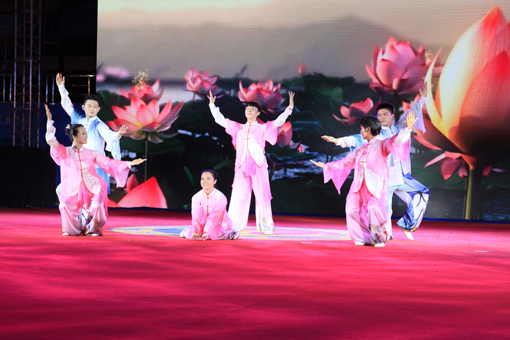
After the “peak experience”, the exerciser shall experience a process of “freedom” and transcendence till he achieves the “Materialization”. “Materialization” is a concept from “Equality of Things” in Zhuang Zi. It refers to the state of the fully unification of self and things in the around world. This is a real state in the aesthetics, and also a dispensable basis of aesthetics. So the process of taking “Materialization” as the aesthetic subject is an absolute state of the unification of self and things, as well as the object and the subject.
In Health Qigong exercise, the exerciser achieves “Quiescence” through “Mind Regulation”, and then accomplishes the aesthetic realm by the spiritual pursuit after “Full Attention”. It is a state that surpasses the “peak experience” with its own “Materialization” characteristics. The “material” in “Materialization” contains, on the basic level, the meaning of exercising techniques. “Material” contains not only all the things except “Self”, but also other matters beyond physical objects. So it is reasonable here to take the exercising techniques as “Material”. However, the object (exercising techniques) and the subject (the exerciser) are inseparable, which is the peculiar foundation for the exerciser to achieve aesthetic “Materialization”. So after the peak experience, the exerciser shall transform his emotion to the exercising techniques and take it as the aesthetic object into his meditation. It is not an ordinary meditation, because the exercising techniques and the exerciser are closely bound; the exerciser may put more emotion into the exercise and make the two into a harmonious combination. Thereby the barrier of the self and the things shall be deleted, self shall become one of the things, and the things become self. There’s no way to tell the two from each other, and so the inner spiritual world of the Health Qigong is achieved.
It is not necessary for every exerciser to experience the aesthetic “Materialization”, since “materialization is the supreme level of the aesthetic experience. It symbolizes that the subject has reached the spiritual world of the aesthetic object, and he has achieved the peak of the aesthetic experience”. If any aesthetic “Materialization” shall be achieved, it will probably be experienced before the end of Health Qigong exercising in the movement of “Winding-Down Exercise to Convey Qi to Dantian”. Because this movement combined “Three Regulations” in one, so it may probably achieve the “Quiescence” with the coordination of the subject and the object, and achieve the spiritual state of “Clearness”- the “reflection of tranquil heart”. “Tranquil Heart” is a reflection of the state in which “the boundary between heart and world, body and soul, as well as the subject and the object shall diminish, and the exerciser’s consciousness is filled with unspeakable feelings.” So it is obvious to see that there are similarities between the effect achieved by performing “Winding-Down Exercise to Convey Qi to Dantian” and the psychology state of “Tranquil Heart”. It is the carrier for the exerciser to achieve aesthetic “Materialization”; and so the better and harmonious the exerciser can combine his body and mind, the deeper level of the aesthetic “Materialization” he shall achieve.
In conclusion, in order to fulfill the exerciser’s spiritual demands, it is necessary to emphasize on the aesthetic characteristics in accordance with different objects and time in Health Qigong teaching and exerting. If we taking this as its motive force, the “brand effect” of Health Qigong shall be highly increased. Thus, the National Fitness Regulations can be better implemented and supported by adopting the body-building game characterized by the health concepts that “the inner experience produced by the body’s practice extends to the external world so that the exerciser can achieve his individual balance through ‘body and mental harmony’, the interpersonal relationship balance through ‘elder and young harmony’ and the balance of nature through ‘heaven and earth harmony’ ”.
(By Si Hongyu)

